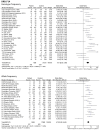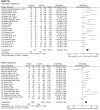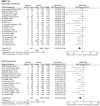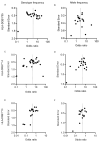A systematic review and meta-analysis of HLA class II associations in patients with IgG4 autoimmunity
- PMID: 35654912
- PMCID: PMC9163138
- DOI: 10.1038/s41598-022-13042-2
A systematic review and meta-analysis of HLA class II associations in patients with IgG4 autoimmunity
Abstract
Autoimmune diseases caused by pathogenic IgG4 subclass autoantibodies (IgG4-AID) include diseases like MuSK myasthenia gravis, pemphigus vulgaris or thrombotic thrombocytopenic purpura. Their etiology is still unknown. Polymorphisms in the human leukocyte antigen (HLA) gene locus, particularly in HLA-DRB1, are known genetic susceptibility factors for autoimmune diseases. We hypothesized a similar role for HLA polymorphisms in IgG4-AID and conducted a systematic review and meta-analysis with case-control studies on IgG4-AID based on MOOSE/ HuGENet guidelines. Genotype (G) and allele (A) frequencies of HLA-DQB1*05 (G: OR 3.8; 95% CI 2.44-5.9; p < 0.00001; A: OR 2.54; 95% CI 1.82-3.55; p < 0.00001) and HLA-DRB1*14 (G: OR 4.31; 95% CI 2.82-6.59; p < 0.00001; A: OR 4.78; 95% CI 3.52-6.49; p < 0.00001) and the HLA-DRB1*14-DQB1*05 haplotype (OR 6.3; 95% CI 3.28-12.09; p < 0.00001/OR 4.98; 95% CI 3.8-6.53; p < 0.00001) were increased while HLA-DRB1*13 (G: OR 0.48; 95% CI 0.34-0.68; p < 0.0001; A: OR 0.46; 95% CI 0.34-0.62; p < 0.00001) was decreased in IgG4-AID patients. In conclusion, the HLA-DQB1*05, HLA-DRB1*14 alleles and the HLA-DQB1*05-DRB1*14 haplotype could be genetic risk factors that predispose for the production of pathogenic IgG4 autoantibodies and the HLA-DRB1*13 allele may protect from IgG4 autoimmunity.
© 2022. The Author(s).
Conflict of interest statement
The authors declare no competing interests.
Figures






Similar articles
-
Common Denominators in the Immunobiology of IgG4 Autoimmune Diseases: What Do Glomerulonephritis, Pemphigus Vulgaris, Myasthenia Gravis, Thrombotic Thrombocytopenic Purpura and Autoimmune Encephalitis Have in Common?Front Immunol. 2021 Jan 29;11:605214. doi: 10.3389/fimmu.2020.605214. eCollection 2020. Front Immunol. 2021. PMID: 33584677 Free PMC article. Review.
-
Relation of HLA-DRB1 to IgG4 autoantibody and cytokine production in muscle-specific tyrosine kinase myasthenia gravis (MuSK-MG).Clin Exp Immunol. 2019 Aug;197(2):214-221. doi: 10.1111/cei.13302. Epub 2019 Apr 12. Clin Exp Immunol. 2019. PMID: 30929252 Free PMC article.
-
Association between human leukocyte antigen-DRB1 and human leukocyte antigen-DQB1 alleles and pemphigus vulgaris in Indian patients: A case-control study.Indian J Dermatol Venereol Leprol. 2018 May-Jun;84(3):280-284. doi: 10.4103/ijdvl.IJDVL_1014_16. Indian J Dermatol Venereol Leprol. 2018. PMID: 29582787
-
Human leukocyte antigen class II (DRB1 and DQB1) alleles and haplotypes frequencies in patients with pemphigus vulgaris among the Serbian population.HLA. 2016 May;87(5):367-74. doi: 10.1111/tan.12796. Epub 2016 Apr 12. HLA. 2016. PMID: 27072514
-
A New Classification System for IgG4 Autoantibodies.Front Immunol. 2018 Feb 12;9:97. doi: 10.3389/fimmu.2018.00097. eCollection 2018. Front Immunol. 2018. PMID: 29483905 Free PMC article. Review.
Cited by
-
The role of oxidative post-translational modifications in type 1 diabetes pathogenesis.Front Immunol. 2025 Feb 14;16:1537405. doi: 10.3389/fimmu.2025.1537405. eCollection 2025. Front Immunol. 2025. PMID: 40028329 Free PMC article. Review.
-
Toxin exposure and HLA alleles determine serum antibody binding to toxic shock syndrome toxin 1 (TSST-1) of Staphylococcus aureus.Front Immunol. 2023 Sep 4;14:1229562. doi: 10.3389/fimmu.2023.1229562. eCollection 2023. Front Immunol. 2023. PMID: 37731490 Free PMC article.
-
IgG4 Autoantibodies in Organ-Specific Autoimmunopathies: Reviewing Class Switching, Antibody-Producing Cells, and Specific Immunotherapies.Front Immunol. 2022 Mar 24;13:834342. doi: 10.3389/fimmu.2022.834342. eCollection 2022. Front Immunol. 2022. PMID: 35401530 Free PMC article. Review.
-
HLA dependency and possible clinical relevance of intrathecally synthesized anti-IgLON5 IgG4 in anti-IgLON5 disease.Front Immunol. 2024 May 16;15:1376456. doi: 10.3389/fimmu.2024.1376456. eCollection 2024. Front Immunol. 2024. PMID: 38827736 Free PMC article.
-
MHC Class II Presentation in Autoimmunity.Cells. 2023 Jan 14;12(2):314. doi: 10.3390/cells12020314. Cells. 2023. PMID: 36672249 Free PMC article. Review.
References
Publication types
MeSH terms
Substances
Grants and funding
LinkOut - more resources
Full Text Sources
Medical
Research Materials

